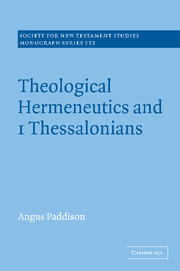Book contents
- Frontmatter
- Contents
- Foreword
- Preface
- List of abbreviations and notes about citation
- Introduction
- Part I The critical task
- Part II An exploration of some pre-modern readings of 1 Thessalonians
- Part III A proposed reading of 1 Thessalonians
- 5 Death and resurrection in 1 Thessalonians
- Conclusion
- Bibliography
- Index of Biblical references
- Index of authors
- Index of subjects
5 - Death and resurrection in 1 Thessalonians
Published online by Cambridge University Press: 02 November 2009
- Frontmatter
- Contents
- Foreword
- Preface
- List of abbreviations and notes about citation
- Introduction
- Part I The critical task
- Part II An exploration of some pre-modern readings of 1 Thessalonians
- Part III A proposed reading of 1 Thessalonians
- 5 Death and resurrection in 1 Thessalonians
- Conclusion
- Bibliography
- Index of Biblical references
- Index of authors
- Index of subjects
Summary
Introduction
Were it not for the insights accrued from both Thomas’ and Calvin's commentaries on 1 Thessalonians, it would be difficult to discern what interpretative strategies should be prioritised in this proposed theological interpretation of 1 Thessalonians. Calvin evidenced the importance and vitality of an eschatological vision, a vision loyal to the whole of 1 Thessalonians, operating with a tension between the transcendence of the future and salvation as a principle already at work in the world. We saw in Thomas’ commentary the potential of a Christological sensitivity to the exegesis of the resurrection's causality charted by the apostle Paul in 1 Thess. 4: 14.
Standing in this corporate endeavour to understand Paul, like Thomas we shall want to wrestle with the causality of Christ's resurrection, about how the One who died and rose for us is the pledge of our future salvation. And echoing Calvin, we shall be keen to develop a mode of reading which has at its core Paul's own eschatological witness, but demonstrates that the resurrection of the dead not only comprises the ‘crown of the whole Epistle, but also provides the clue to its meaning, from which place light is shed on the whole, and it becomes intelligible, not outwardly, but inwardly, as a unity’.
Critical fidelity to Thomas’ and Calvin's exegetical insights, using their readings as tools in our own conceptual expansion of Paul's witness, implies that a number of things can be expected in this chapter's method and focus.
- Type
- Chapter
- Information
- Theological Hermeneutics and 1 Thessalonians , pp. 139 - 186Publisher: Cambridge University PressPrint publication year: 2005



